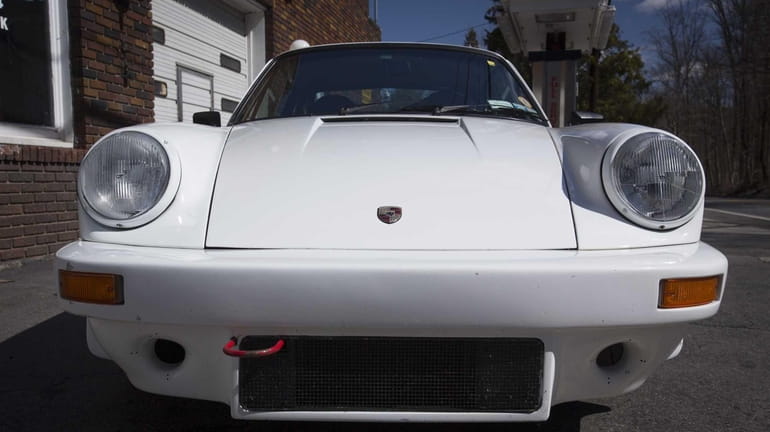Vintage Porsche 911s coveted for unmatched driving feel

The front of a 1974 Porsche 911 Carrera vehicle, prepared by Brumos Racing, is seen in Croton-on-Hudson in New York. (April 2, 2013) Credit: Bloomberg News
It’s so loud in here that I might as well be operating farm machinery. The cabin reeks of gas, wafting in from the flat-six engine located in the rear of the car. My shoulders are sore from cranking the heavy steering wheel and the frame of the car bucks with every bump in the road.
I’m having the time of my life.
A buddy and I are flinging a 1970s Porsche 911 down a narrow road. The tiny car is white, with black "Carrera" lettering down the side and a sizable wing jutting from the rear. It looks so classic, so throw-back sexy, that I could just leer at it all afternoon.
No, on second thought, I’d rather drive. It’s a street-legal race car of the era, a regular 1974 model customized to compete on the racetrack. It was fast back then. These days, a Honda Accord is quicker.
Speed isn’t the point. I’ve tested all of the Porsches released in the last dozen years - all plenty fast - but never one manufactured when I was still in diapers.
This year is the 911’s 50th anniversary and it’s high time I discovered for myself what all the original fuss was about.
With a rear-mounted engine, sloped roof and tall side fenders, a 911 is instantly identifiable. Few cars are as coveted. There are entire websites devoted to finding and buying an older 911. I too have the yen and I’ll soon see if this drive throws gas on the fire.
The car is owned by Classic Car Club Manhattan, where members pay $10,000 annually to drive a spectacular collection of modern Ferraris, American muscle cars and various 911s.
Club director Mike Prichinello says he paid $32,000 in cash for the 1974 Porsche. "I buy lots of used cars and I always look at the seller’s lawn first," he counsels. "A sure sign of how they maintained the car."
This 911’s history is murky, he says, but it may have been raced by Florida’s Brumos Racing. (Racing legend Hurley Haywood, a Brumos driver at the time, says he doesn’t remember this car specifically.)
Heavily modified, it has race shocks, a mechanical fuel injector and a fuel cell for containing gasoline spills in case of a wreck. It is far from period perfect - the steering wheel and the stick shift are both after-market for instance - but it is pristine. It fires up without a hitch.
Fires is the operative word. As soon the 2.7-liter, air-cooled flat-six comes to life, my friend and I realize we’ll have to yell to be heard. The 1974 stock engine was reported to put out 150 horsepower, but this car’s powertrain have been tweaked for as much as 220 hp.
The five-speed manual stickshift requires finesse. Second gear asks for a gentle touch, and more than once I messily induce a horrible grinding nose. (Sorry, Mike.) Still, when I first pull out of the Classic Club’s Tribeca garage into heavy traffic, the car is easier to drive than expected.
Creature comforts are few. To save weight, it has no air conditioner, no radio and certainly nothing electronic. Yet the shape of the dashboard will be familiar to Porsche owners today, and the leather seats comfortable.
The upright seating position puts you very close to the windshield’s curved glass, and while the thin A-pillars wouldn’t pass modern safety regulations, the sightlines are exceptional. You can see through corners perfectly.
There’s no assist on the steering, and it requires considerable heft to turn the wheel, demanding two hands at all times. Any idle tug of the wheel elicits a directional change. Several times when I find myself looking at the landscape the car veers in that direction.
But on narrow curving lanes upstate, the car firms to the road and a slight tilt of steering wheel is all it needs to carve through corners. Shifting between third and fourth gears is immensely satisfying, with a smooth clink of gears. The engine sounds like an aged opera tenor with a four-packet-a-day smoking habit.
Perhaps it’s the effect of all that gas seeping into the cockpit, but I’m euphoric. The car feels alive. We’re blurring through the scenery, our butts seemingly hanging only inches from the asphalt. The feedback from the steering wheel transmits every crack and pebble on the road.
We’re not really going all that fast, though. I’m concentrating intensely when a Toyota passes us. The driver glances over. She’s on her mobile phone, steering with one hand, relaxed.
Modern cars are packed with computers and have efficient engines flush with power. I could navigate these same curvy roads in a new 911 at three times the speed and never feel like I was pushing.
But it wouldn’t be nearly as much fun or involving. This is exactly why buyers spend months looking for that perfect, vintage, 911.
